-
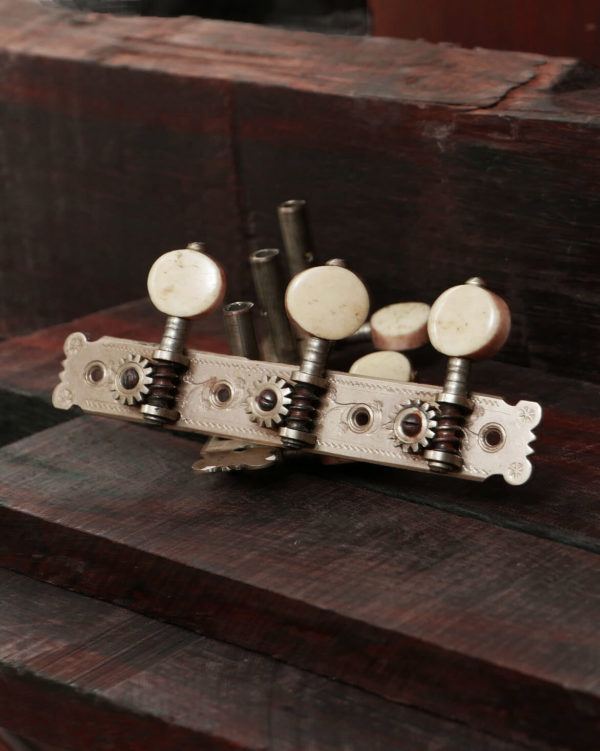 Rare set of Seidel Tuners. Seidel tuners, made in Germany in the 19th century, were CF Martin’s tuner of choice for his high-end guitars. You can see these tuners on some rare 1860 – 1880’s Martins– but they are very rare to encounter not married to a guitar. German silver backplates; floral pattern decorations, hand-engraved, The original buttons are of genuine bone. Good working order. Price: $1295.
Rare set of Seidel Tuners. Seidel tuners, made in Germany in the 19th century, were CF Martin’s tuner of choice for his high-end guitars. You can see these tuners on some rare 1860 – 1880’s Martins– but they are very rare to encounter not married to a guitar. German silver backplates; floral pattern decorations, hand-engraved, The original buttons are of genuine bone. Good working order. Price: $1295. -
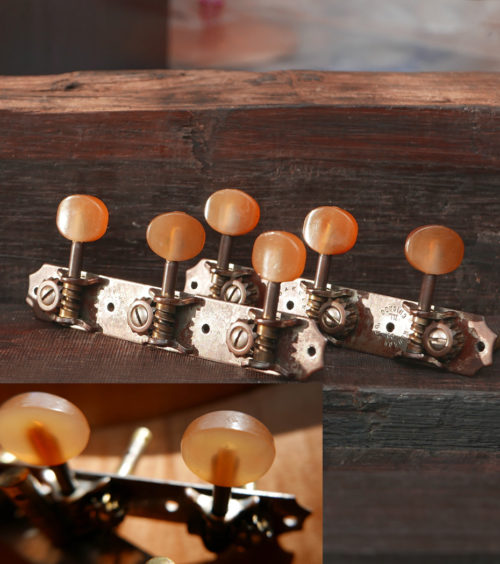 Pre-war Kluson tuners from the 1930's. Amber buttons. These are rare tuners that came on some of the nice Gibsons of the era, such as a few Gibson J35's. Good working condition. Price: $295. – on Hold
Pre-war Kluson tuners from the 1930's. Amber buttons. These are rare tuners that came on some of the nice Gibsons of the era, such as a few Gibson J35's. Good working condition. Price: $295. – on Hold -
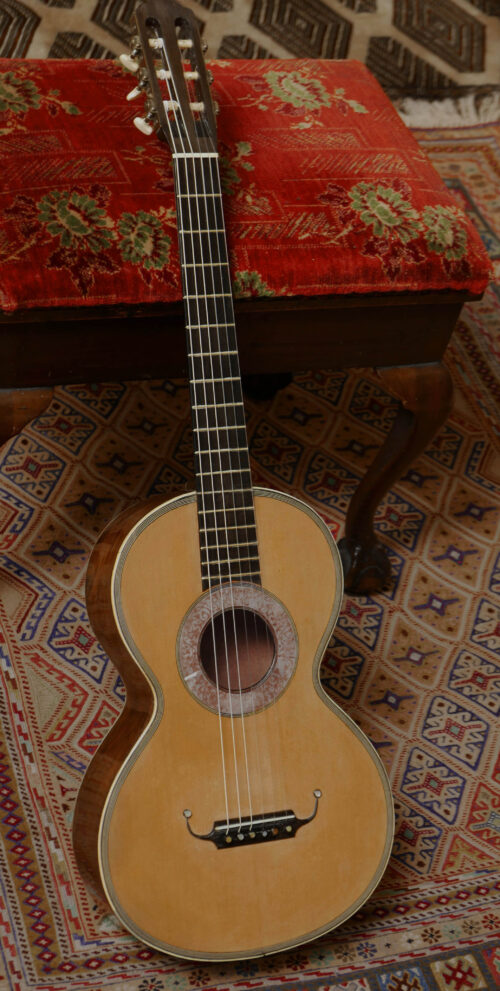 Pierre Marcard, well-known luthier in France, 1794-1867. This guitar is from about 1845–1850. Signed with the maker’s stamp/signature on inside, back (see photo). • All original: finish, bridge, frets, endpin, everything • Spruce top • Ebony bridge • Finely decorated mother of pearl rosette • Brazilian rosewood/maple laminate back • Solid Brazilian rosewood sides (note this is rare: solid, it was an upgrade from the standard practice of the day to do laminate sides as well. • Scale length: 632mm • Nut width: 46mm You can see a sound/video clip of this guitar being played, here: https://www.youtube.com/watch?v=Ryf25bMcmt4 Condition: Amazing original condition. • Similar to other fine guitars of that era, from Lacote and others, the "finish" on the top of the guitar – still all original finish and unmolested – is super thin. Those master French luthiers thought that less finish on top, was better. • No cracks on top, back, sides • A few tiny and superficial surface “cracks” on a few sections of binding • Bridge, all original, has never been off the instrument. Saddle looks original. The bridge does have a few cracks in the ebony, parallel to the length of the bridge. We have left them as is, for originality (a luthier might fill in the tiny gaps with ebony paste – the structure/integrity of the bridge is good.) • The bridge pins look original to the guitar, but hard to verify that. • Action of the guitar is good, consistent with mid nineteenth century standards. • Tone of the guitar, is excellent. Good projection for this sized instrument. Playability is very good– with good intonation even at high registers. Price: $8250. Will ship in a modern hard shell case.
Pierre Marcard, well-known luthier in France, 1794-1867. This guitar is from about 1845–1850. Signed with the maker’s stamp/signature on inside, back (see photo). • All original: finish, bridge, frets, endpin, everything • Spruce top • Ebony bridge • Finely decorated mother of pearl rosette • Brazilian rosewood/maple laminate back • Solid Brazilian rosewood sides (note this is rare: solid, it was an upgrade from the standard practice of the day to do laminate sides as well. • Scale length: 632mm • Nut width: 46mm You can see a sound/video clip of this guitar being played, here: https://www.youtube.com/watch?v=Ryf25bMcmt4 Condition: Amazing original condition. • Similar to other fine guitars of that era, from Lacote and others, the "finish" on the top of the guitar – still all original finish and unmolested – is super thin. Those master French luthiers thought that less finish on top, was better. • No cracks on top, back, sides • A few tiny and superficial surface “cracks” on a few sections of binding • Bridge, all original, has never been off the instrument. Saddle looks original. The bridge does have a few cracks in the ebony, parallel to the length of the bridge. We have left them as is, for originality (a luthier might fill in the tiny gaps with ebony paste – the structure/integrity of the bridge is good.) • The bridge pins look original to the guitar, but hard to verify that. • Action of the guitar is good, consistent with mid nineteenth century standards. • Tone of the guitar, is excellent. Good projection for this sized instrument. Playability is very good– with good intonation even at high registers. Price: $8250. Will ship in a modern hard shell case. -
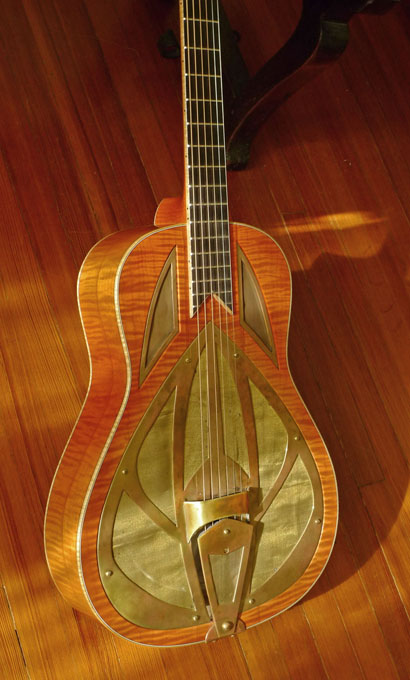 This stunningly beautiful, one-of-a-kind custom built resonator (from 2006, in beautiful crack-free condition and with only light wear) is from Tony Nobles, well-known luthier, and maker of instruments for Joe Walsh, Billy Gibbons and many other artists. The art deco ornamentation compliments an incredibly well built instrument, with meticulous attention to detail. Listen to/watch the video clip where guitar master Redd Volkaert put this instrument through some interesting jazz and blues paces.
This stunningly beautiful, one-of-a-kind custom built resonator (from 2006, in beautiful crack-free condition and with only light wear) is from Tony Nobles, well-known luthier, and maker of instruments for Joe Walsh, Billy Gibbons and many other artists. The art deco ornamentation compliments an incredibly well built instrument, with meticulous attention to detail. Listen to/watch the video clip where guitar master Redd Volkaert put this instrument through some interesting jazz and blues paces.- Spun-aluminum Quartermane biscuit-style cone (single-cone resonator)
- Solid curly maple, back top, and sides, with light tobaccoburst nitrocellulose lacquer finish
- Art deco coverplate, soundholes, and tailpiece of antiqued brass with a metal mesh covering
- Maple binding on body
- Custom torch inlay on headstock
- Curly maple neck
- Waverly tuners
- Scale: 24.4 inches
- Nut width: 1 7/8 inch
- String spacing at nut: 1 18/32
- Bridge spacing: 2 1/8
- Lower Bout: 14 1/2
- Upper bout: 9 1/2
- Body depth at bottom: 3 ¾ inches
- Body depth at neck joint: 3-20/32
-
 When this concert guitar was made in 1976, it was the top model offered by the master luthier Masaru Kohno– when he was at the very height of his career. There is some confusion out there as to which Kohno was the “top” concert model at any given date in height of Masaru Kohno’s career– from the early 70’s to the late-80s’. No confusion here– as there is correspondence (from August 2011) directly from Masaki Sakurai to us, regarding this guitar. Masaki Sakurai (nephew of Masaru Kohno, who in fact worked along side Masaru Kohno when this instrument was made in 1976, and now of course runs the “Sakurai/Kohno” shop, since the death of Masaru Kohno in 1998) confirms that this guitar was the top model available from Kohno in mid-1976. (Don’t be confused– a later, for example 1980 No. 30 Kohno is not a top Kohno model from that year. By 1980, the top model was a No. 50.) The confusion arises because Kohno had, in the early 70s until the late 80’s the custom of making his model numbers correspond to the guitars’ price in Japanese Yen. Hence, this guitar, a “No. 30”, in mid-1976, was priced at 300,000 Japanese Yen, and was the top model (a very expensive guitar in 1976). The confusion arises because as the inflation-prone 70’s continued, everyone adjusted prices upward. When inflation kept advancing, Kohno model numbers were something of a moving target, and the “top model” number changed upwards over time. Over time the top model moved up to No. 30 (this guitar), and then later No. 50 (starting in 1977). Kohno finally stopped using numbers in the 80’s and then called the top model the “Professional J”, and on, with more variations of “Professional”.) In any case this guitar, was the top model made, when it came from the Kohno shop (correspondence from Masaki Sakurai confirming this, will be supplied). But the real proof is in the playing. This instrument stands along with the best brazilian rosewood/spruce concert guitars from any maker, anywhere, any period. Crystal clear brazilian trebles. Wonderful resonance, combined with superior string separation.
When this concert guitar was made in 1976, it was the top model offered by the master luthier Masaru Kohno– when he was at the very height of his career. There is some confusion out there as to which Kohno was the “top” concert model at any given date in height of Masaru Kohno’s career– from the early 70’s to the late-80s’. No confusion here– as there is correspondence (from August 2011) directly from Masaki Sakurai to us, regarding this guitar. Masaki Sakurai (nephew of Masaru Kohno, who in fact worked along side Masaru Kohno when this instrument was made in 1976, and now of course runs the “Sakurai/Kohno” shop, since the death of Masaru Kohno in 1998) confirms that this guitar was the top model available from Kohno in mid-1976. (Don’t be confused– a later, for example 1980 No. 30 Kohno is not a top Kohno model from that year. By 1980, the top model was a No. 50.) The confusion arises because Kohno had, in the early 70s until the late 80’s the custom of making his model numbers correspond to the guitars’ price in Japanese Yen. Hence, this guitar, a “No. 30”, in mid-1976, was priced at 300,000 Japanese Yen, and was the top model (a very expensive guitar in 1976). The confusion arises because as the inflation-prone 70’s continued, everyone adjusted prices upward. When inflation kept advancing, Kohno model numbers were something of a moving target, and the “top model” number changed upwards over time. Over time the top model moved up to No. 30 (this guitar), and then later No. 50 (starting in 1977). Kohno finally stopped using numbers in the 80’s and then called the top model the “Professional J”, and on, with more variations of “Professional”.) In any case this guitar, was the top model made, when it came from the Kohno shop (correspondence from Masaki Sakurai confirming this, will be supplied). But the real proof is in the playing. This instrument stands along with the best brazilian rosewood/spruce concert guitars from any maker, anywhere, any period. Crystal clear brazilian trebles. Wonderful resonance, combined with superior string separation.- Hand-signed on label by Masaru Kohno, and dated 1976
- Solid European spruce top
- Solid Brazilian rosewood back and sides
- 660mm scale length
- Nut: 52mm
- Mahogany neck with 2 ebony supporting strips
- Ebony fretboard
- Gold engraved Gotoh tuners
- One repaired crack on back of guitar
- Crack-free top and sides. There are various nicks, dings, and scratches.
- Finish is naturally worn off, through playing, on the center section of the back of the neck– giving it a very fast feel in the left hand.
-
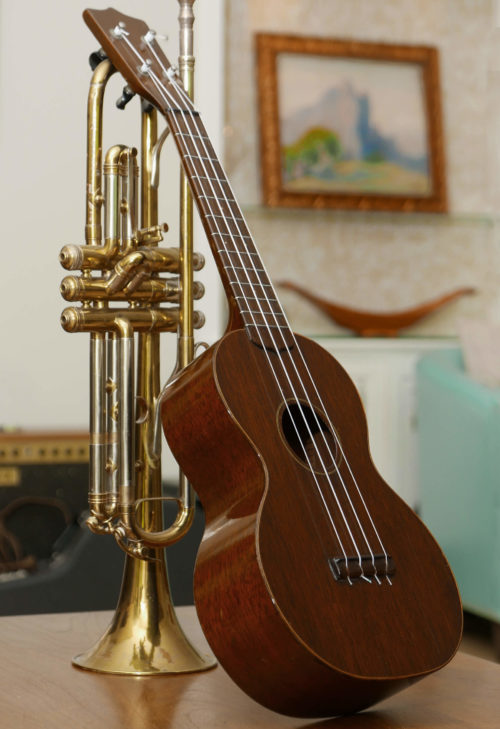 A beautiful example of one of the rarest prewar Martin ukuleles. This is a prewar Martin C-1. (All Concert Model ukuleles from Martin– with the exception of few special orders– were style 1). Officially called the Concert model ukulele, it’s larger than the many soprano size ukes. It’s very rare to find a prewar C-1 on the market– and much rarer still to find a pre-1933. This instrument was made between 1925 and 1933– because of the Martin stamp on the back of the headstock and the lack of the (post-1933) Martin decal on the front of the headstock. This is currently the only Martin C-1 from the late 1920’s on the market. And the tone and playability are perfect. Louder, and more bell like tone than a Martin Style 1 soprano uke. Martin concert ukuleles are the same body size as taropatch (1918-1932) but with four strings only. While the taropatch had been offered with four strings since its introduction, the new concert model was different in that it had a narrower neck and a standard soprano-size bridge. It was added to the standard catalog that year and by 1927 it was outselling all taropatch models combined. Concerts ukuleles are tuned the same as the sopranos but because of the larger body have a deeper and richer sound, and a slightly longer, easier to play scale length of 14 3/4". The Concert Ukulele from Martin–while rare to find a prewar example– is considered the ideal size for players– larger than the tiny soprano but not too big like the Martin Tenor uke. This one has a rich, beautiful tone, and it’s almost unplayed condition. The action is perfect. There is one small crack on top–but it’s essentially “cleated” by the orignal bridde plate and does not need addressing, and a smaller finish crack that does not go through to the inside). The braces and all else inside: pristine. And it even comes in its original canvas case. Like most Martin ukes, the mahogany bridge had some wear on the string slots. So we created a new, replacement, 100% historically correct replacement bridge. Original patent tuners Original ebony nut Brazilian rosewood fretboard Style 1: all mahogany, with brazilian binding on top Total length: 23 ¼ inches Body length: 11 inches Body width upper bout: 5 ¾ inches Body width lower bout: 7 5/8 inches Scale length: 14 ¾ inches Price: with original case. $2150.
A beautiful example of one of the rarest prewar Martin ukuleles. This is a prewar Martin C-1. (All Concert Model ukuleles from Martin– with the exception of few special orders– were style 1). Officially called the Concert model ukulele, it’s larger than the many soprano size ukes. It’s very rare to find a prewar C-1 on the market– and much rarer still to find a pre-1933. This instrument was made between 1925 and 1933– because of the Martin stamp on the back of the headstock and the lack of the (post-1933) Martin decal on the front of the headstock. This is currently the only Martin C-1 from the late 1920’s on the market. And the tone and playability are perfect. Louder, and more bell like tone than a Martin Style 1 soprano uke. Martin concert ukuleles are the same body size as taropatch (1918-1932) but with four strings only. While the taropatch had been offered with four strings since its introduction, the new concert model was different in that it had a narrower neck and a standard soprano-size bridge. It was added to the standard catalog that year and by 1927 it was outselling all taropatch models combined. Concerts ukuleles are tuned the same as the sopranos but because of the larger body have a deeper and richer sound, and a slightly longer, easier to play scale length of 14 3/4". The Concert Ukulele from Martin–while rare to find a prewar example– is considered the ideal size for players– larger than the tiny soprano but not too big like the Martin Tenor uke. This one has a rich, beautiful tone, and it’s almost unplayed condition. The action is perfect. There is one small crack on top–but it’s essentially “cleated” by the orignal bridde plate and does not need addressing, and a smaller finish crack that does not go through to the inside). The braces and all else inside: pristine. And it even comes in its original canvas case. Like most Martin ukes, the mahogany bridge had some wear on the string slots. So we created a new, replacement, 100% historically correct replacement bridge. Original patent tuners Original ebony nut Brazilian rosewood fretboard Style 1: all mahogany, with brazilian binding on top Total length: 23 ¼ inches Body length: 11 inches Body width upper bout: 5 ¾ inches Body width lower bout: 7 5/8 inches Scale length: 14 ¾ inches Price: with original case. $2150. -
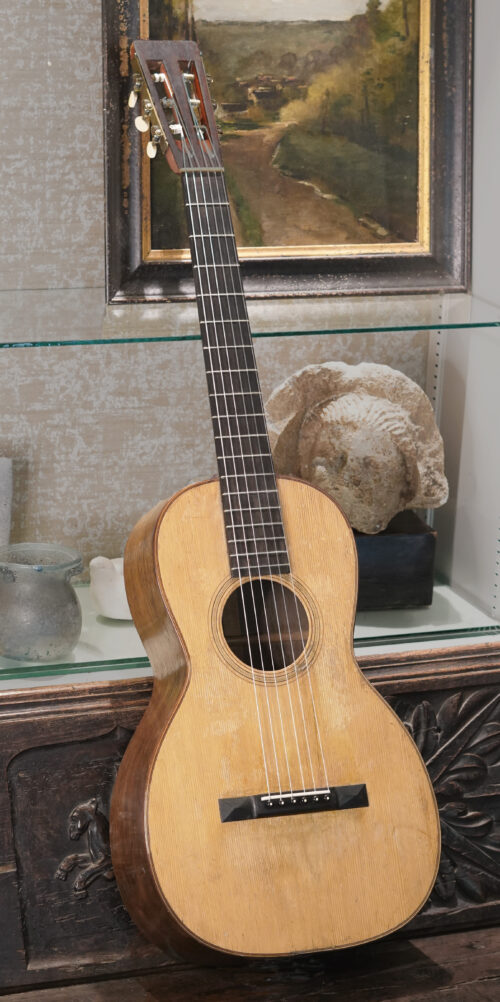
In this period, the Martin factory foreman often wrote the date of manufacture, before the guitar left the factory, hand-written in pencil on the underside of the top. This one has hand-written inside "5 / 1886". It’s a nice touch to a great Martin – and the size 2 is a great size, it’s a larger guitar than the more common size 2 ½ from this era.
Exquisite tone from this guitar. See and hear this guitar being played:
All careful work has been done on this guitar, including a perfect ebony bridge by T.J. Thompson, and it won’t need anything else. It’s an ideal guitar for the player who wants the best Martin tone and playability – a tonal gem from the 19th century Martin factory in Nazareth.
• Slot head, with original geared tuners
• Spruce top over Brazilian Rosewood back and sides.
• All original finish, with the exception of some minor touch up in the bridge area.
• Perfect reproduction ebony, pyramid bridge by T.J. Thompson.
Some touch-up in the bridge area of the spruce when the bridge was fitted.
• Fan braced – as are most of the best sounding Martins from this era.
• Original thin maple bridge plate, that has had some minor pin hole attention, by us, to ensure stability and protection from ball ends.
• Original ebony fretboard; Original bar frets. Frets have some wear, but we left them, for originality, and they play fast and low and smooth.
• Spanish heel (not the ice cream cone heel of the less expensive Martins of the era).
• Soft V neck
• End pin is original, tab end of the pin has come off but the shaft remains
• One inch area in the rosette, repaired (see photos)
• Three tiny holes near end pin are remnant of a tailpiece used at some point in the previous century
• One crack on top, just below the low E string (see photos). About 4 1/2 inches long. This crack has been glued, and is tight (no cleat due to proximity to a brace).
• Scale length: 24.5 inches
• Width at lower bout: 12 inches
• Nut width: 1 13/16 inch
The guitar has had a recent neck set (by us), so the action is great, and lower than what a lot of folks try to get away with on a 19th century Martin. This guitar does not have “classical guitar action.” The great Martins from this era were not then and they should not today be considered “classical guitars”. They are parlor guitars, and the best examples have the Martin sound we know and love, with a “classical” sound if we consider that sound from the 19th century not today.
No excuses on the action, tone, and playability on this guitar. Strung with Savarez Alliance strings. It plays so easily, with perfect intonation all the way up the fretboard, and the sound is stellar.
It ships in a modern hard shell case.
Price: $6,750. – plus shipping
-
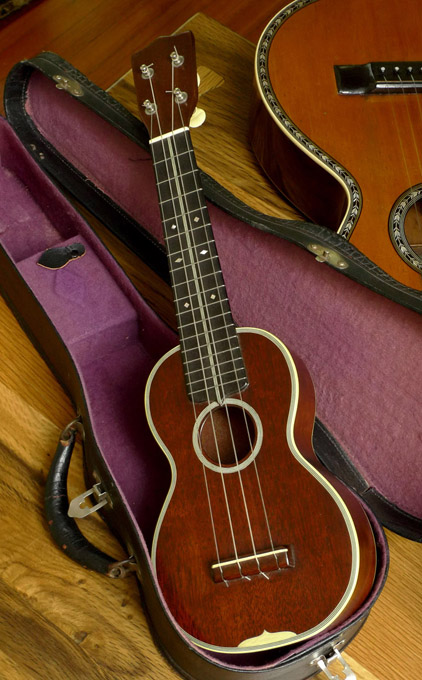 In the 1920’s and early 30's, the Hawaiian craze was in full bloom, and ukulele production was crucial to Martin’s success in this period. This is a wonderful, extremely well-preserved example of one of the most ornate of the Martin ukuleles, still in its original Geib case. Although Martin ukes built after 1916 carried no serial number, it’s possible to generally date them by stylistic elements. This Martin Style 3 is from the best era, the golden era, from about 1925 to 1930. Martin style 3 was first made in 1918. Martin Style 3, soprano (standard) specs:
In the 1920’s and early 30's, the Hawaiian craze was in full bloom, and ukulele production was crucial to Martin’s success in this period. This is a wonderful, extremely well-preserved example of one of the most ornate of the Martin ukuleles, still in its original Geib case. Although Martin ukes built after 1916 carried no serial number, it’s possible to generally date them by stylistic elements. This Martin Style 3 is from the best era, the golden era, from about 1925 to 1930. Martin style 3 was first made in 1918. Martin Style 3, soprano (standard) specs:- Mahogany body
- 7 layer top binding
- 3 layer back binding
- Ebony fretboard
- 5 layer soundhole ring
- Celluloid ornament on top, behind bridge (known as the "parend", or “shield”)
- Bar frets
- Small pearl paired-diamond inlays at fret 5, 7, and 9
- Three lines inlaid down center of fingerboard
- Nickel plated pegs (introduced in 1923)
- CF Martin & Co, stamped on back of peghead, and inside-back (Martin logo was not put on front of peghead until 1932)
-
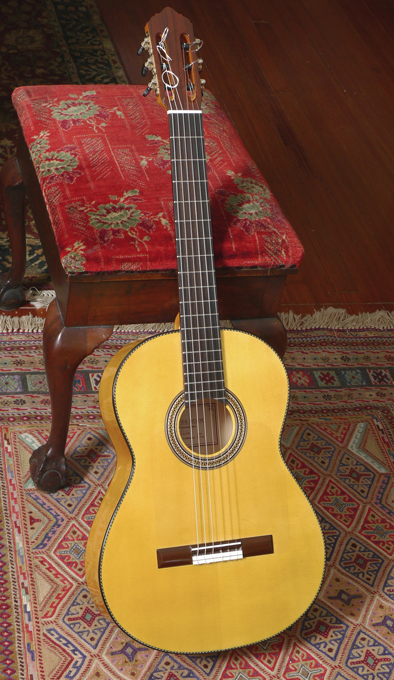 Brand new, Lester Devoe Flamenco Blanca, custom made (details on request). Lester Devoe needs no introduction to the world’s top flamenco players. His reputation was established decades ago (and his new models are the best ever made, and in huge demand worldwide). His guitars are played by the world’s top performing and recording flamenco artists. This instrument, custom made with a unique Spanish Cypress to add a more robust treble response to the legendary deep, throaty, percussive bass response of the Devoe Blanca, will amaze.
Brand new, Lester Devoe Flamenco Blanca, custom made (details on request). Lester Devoe needs no introduction to the world’s top flamenco players. His reputation was established decades ago (and his new models are the best ever made, and in huge demand worldwide). His guitars are played by the world’s top performing and recording flamenco artists. This instrument, custom made with a unique Spanish Cypress to add a more robust treble response to the legendary deep, throaty, percussive bass response of the Devoe Blanca, will amaze.- Flamenco Blanca
- 650mm scale length
- Spanish cypress back and sides (custom, details on request)
- European spruce top
- Ebony fingerboard
- Sloane tuners
- Rosewood headstock veneer
- Cedar neck
- Nitrocellulose lacquer finish
-
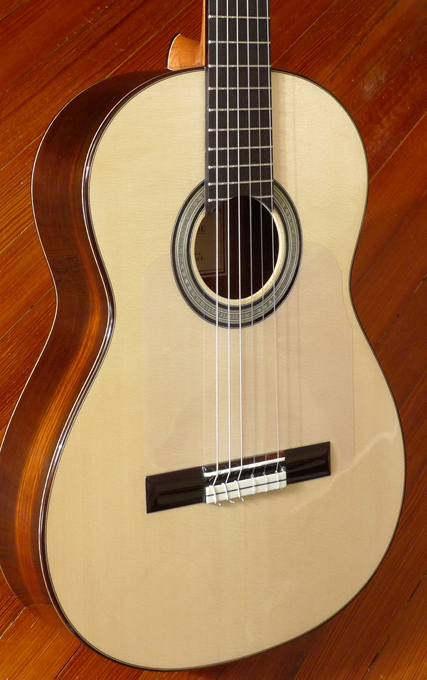 This new, custom made Lester Devoe Flamenco Negra is amasterpiece, from one of the world’s top luthiers. Lester Devoe needs nointroduction to the world’s great Flamenco players. The late, legendary Sabicasplayed a Devoe– and converted some of the great Flamenco players in Spain tothe fold. Paco De Lucia, and Vicente Amigo, among others, play Devoe Flamencoguitars. Paco De Lucia began playing a Devoe Negra guitar years ago– and thereare many Paco De Lucia recordings and feature films where Paco plays a DevoeFlamenco guitar.) This is the second custom guitar, that Lester has made for uswith select, old growth, quartersawn AAAAA Brazilian rosewood. Signed by LesterDevoe, 2012 (March).
This new, custom made Lester Devoe Flamenco Negra is amasterpiece, from one of the world’s top luthiers. Lester Devoe needs nointroduction to the world’s great Flamenco players. The late, legendary Sabicasplayed a Devoe– and converted some of the great Flamenco players in Spain tothe fold. Paco De Lucia, and Vicente Amigo, among others, play Devoe Flamencoguitars. Paco De Lucia began playing a Devoe Negra guitar years ago– and thereare many Paco De Lucia recordings and feature films where Paco plays a DevoeFlamenco guitar.) This is the second custom guitar, that Lester has made for uswith select, old growth, quartersawn AAAAA Brazilian rosewood. Signed by LesterDevoe, 2012 (March).- 650mm scale length
- Nut: 52mm
- Neck width at nut: 52mm
- 80 year old Brazilian Rosewood (pre-CITES) back and sides (Quartersawn).
- European spruce top
- Cedar neck
- Brazilian Rosewood headstock overlay, and bridge
- Brazilian Rosewood body binding, top and back
- Ebony fingerboard
- Sloane tuners
- Nitrocellulose lacquer finish
-
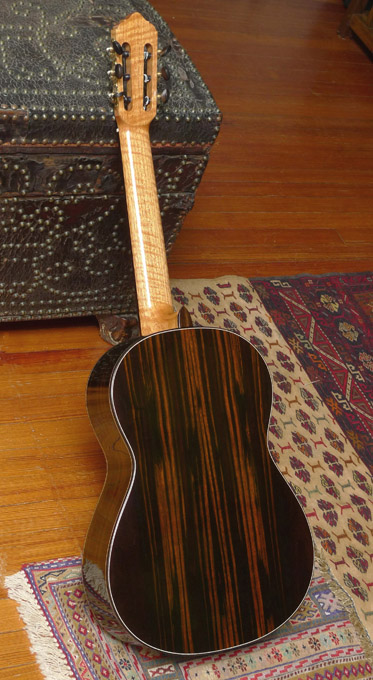 Vustom made Lester Devoe Flamenco Negra, a one-of-a-kind, Brazilian Rosewood guitar, from one of the world’s top luthiers. Lester Devoe needs no introduction to the world’s great Flamenco players. The late, legendary Sabicas played a Devoe– and converted some of the great Flamenco players in Spain to the fold. Paco De Lucia, and Vicente Amigo, among others, play Devoe Flamenco guitars. (I personally delivered a Devoe Flamenco Blanca guitar to Paco De Lucia in Spain in late 2010– Paco likes his Devoe’s hand-delivered. Paco De Lucia began playing a Devoe Negra guitar years ago– and there are many Paco De Lucia recordings and feature films where Paco plays a Devoe Flamenco guitar.) And it’s rare that Lester makes a Negra with Brazilian rosewood of this age and quality.
Vustom made Lester Devoe Flamenco Negra, a one-of-a-kind, Brazilian Rosewood guitar, from one of the world’s top luthiers. Lester Devoe needs no introduction to the world’s great Flamenco players. The late, legendary Sabicas played a Devoe– and converted some of the great Flamenco players in Spain to the fold. Paco De Lucia, and Vicente Amigo, among others, play Devoe Flamenco guitars. (I personally delivered a Devoe Flamenco Blanca guitar to Paco De Lucia in Spain in late 2010– Paco likes his Devoe’s hand-delivered. Paco De Lucia began playing a Devoe Negra guitar years ago– and there are many Paco De Lucia recordings and feature films where Paco plays a Devoe Flamenco guitar.) And it’s rare that Lester makes a Negra with Brazilian rosewood of this age and quality.- 650mm scale length
- Nut: 52mm
- Neck width at nut: 52mm
- String Spacing at nut: 44mm
- 80 year old Brazilian Rosewood (pre-CITES) back and sides (Quartersawn).
- European spruce top, with some beautiful and understated “"hazelfichte" (what Americans call bear claw).
- Custom, flamed Spanish Cedar neck
- Brazilian Rosewood headstock overlay, and bridge
- Brazilian Rosewood body binding, top and back
- Ebony fingerboard
- Sloane tuners
- Austere yet elegant Santos style black and white rosette, that Devoe uses only rarely, on top custom models
- Nitrocellulose lacquer finish
-
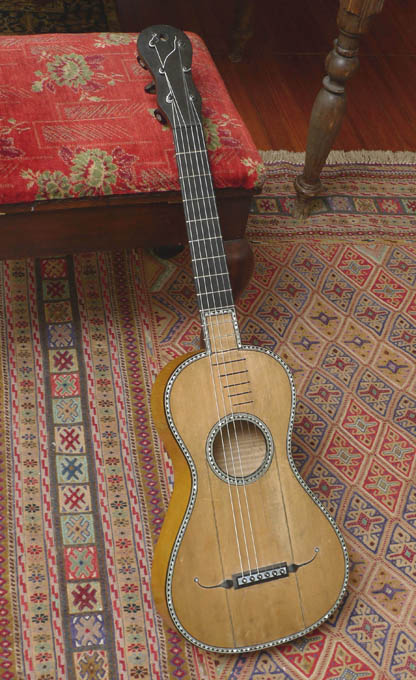 This fine and early example of the French guitar was made in Mirecourt, France, around 1800 to 1810. And sold through the famous Parisian dealer Koliker. It is a rare early example, as indicated by its rectangular bridge that does not have a separate saddle, but uses the top edge of the ebony rectangle as the saddle (this feature places it circa 1800, not like the more common 1820-1840 French guitars that have a more modern style bridge including a regular saddle). But for all its rarity, and exoticism to modern eyes, the most salient feature of this guitar is that it plays wonderfully. This is no museum piece to hang on a wall or shelf. This guitar is to play and enjoy. It plays beautifully, with all frets in tune. With no buzzing... I have had guitars from the 1960’s that do not play as well, in tune, and sound as well as this one. Even the action is perfect. The guitar has a wonderful tone, with a sweetness and brightness from the maple, and full bass response.
This fine and early example of the French guitar was made in Mirecourt, France, around 1800 to 1810. And sold through the famous Parisian dealer Koliker. It is a rare early example, as indicated by its rectangular bridge that does not have a separate saddle, but uses the top edge of the ebony rectangle as the saddle (this feature places it circa 1800, not like the more common 1820-1840 French guitars that have a more modern style bridge including a regular saddle). But for all its rarity, and exoticism to modern eyes, the most salient feature of this guitar is that it plays wonderfully. This is no museum piece to hang on a wall or shelf. This guitar is to play and enjoy. It plays beautifully, with all frets in tune. With no buzzing... I have had guitars from the 1960’s that do not play as well, in tune, and sound as well as this one. Even the action is perfect. The guitar has a wonderful tone, with a sweetness and brightness from the maple, and full bass response.- All original finish on the guitar
- Flamed solid Maple back and sides
- Spruce top, with no finish on the spruce… this is a characteristic of guitars from this time and place. While the back and sides of the guitar were French polished, the spruce top was left as natural wood, with no finish.
- One of the friction pegs is a modern replacement
- The two dark splices on the soundboard are later, but still 19th century, restorations, done as decorative flourishes.
- Scale length: 64.3 cm
- Length of body: 43.3 cm
- Koliker, Luthier Rue Croix-des-Petits Champs No. 24 A. Paris